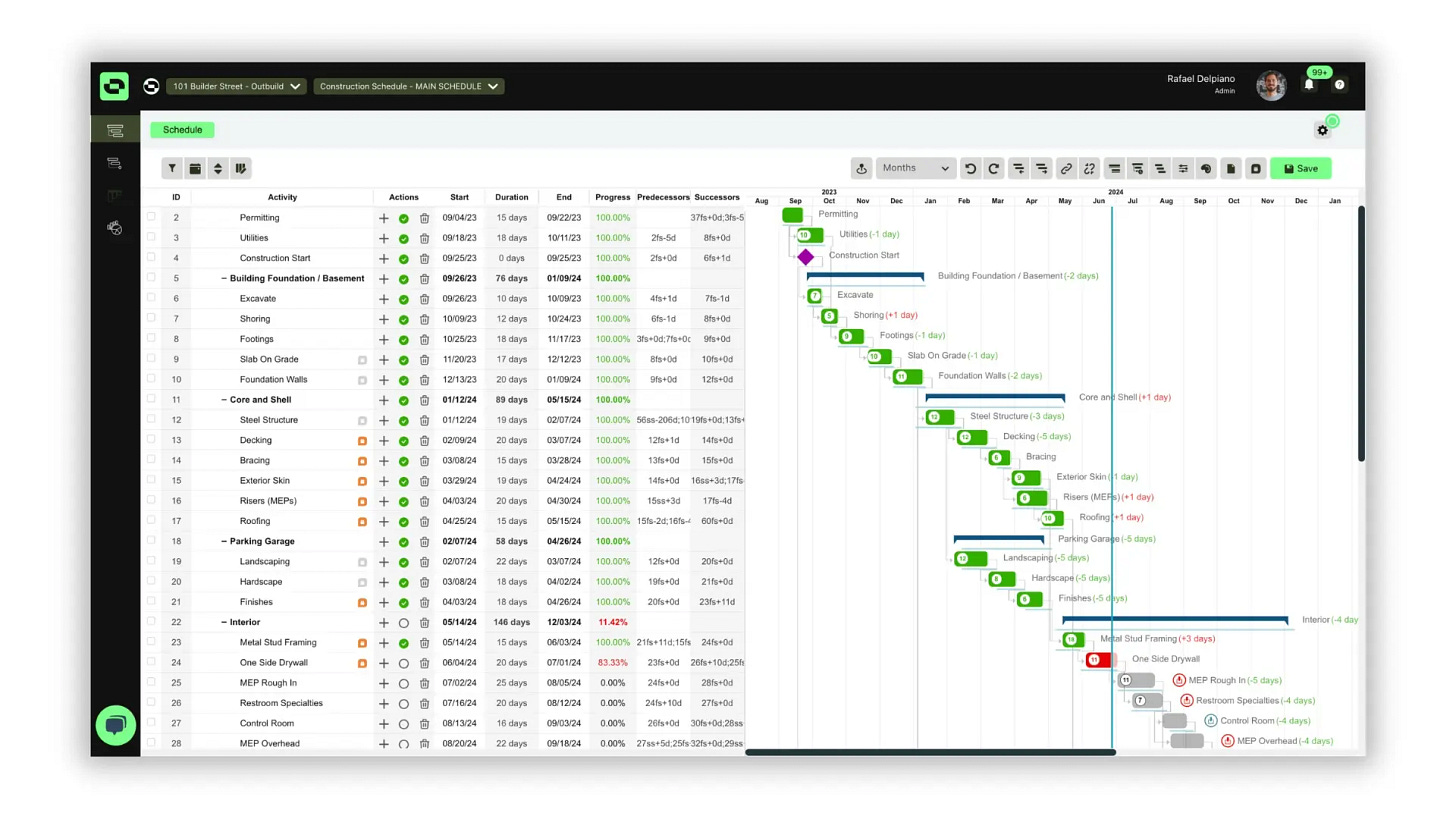A Project Leader’s Guide to Conflict Resolution
How to turn conflict from productivity killer to leadership multiplier.
👋 Hey, Kyle here! Welcome to The Influential Project Manager, a weekly newsletter covering the essentials of successful project leadership.
Today’s Overview:
The average construction team wastes 120+ hours per week to unresolved conflict. That’s like paying 3 full-time salaries for people to hurt productivity.
89% of workplace conflicts escalate, yet only 22% of employees think their managers handle disputes effectively—your team needs you to master a skill you probably lack.
The 4-word question that stops million-dollar arguments before they start (most "leaders" will never ask it).
🏗️ PERFECT YOUR PLANNING ROUTINE WITH OUTBUILD!
Helping projects prevent delays to stay on schedule.
Outbuild is designed for one thing: to make construction scheduling simple, connected, and effective. It’s the trusted choice of top contractors. Here’s why:
✅ User-Friendly: Intuitive drag-and-drop features let your team get started immediately without any long training sessions.
✅ Collaborative: Everyone—from trade partners to PMs and PEs—can log in, plan their work, and communicate directly in one centralized platform.
✅ Integrated: Outbuild syncs effortlessly with Procore and others, keeping all your project workflows in one place.
✅ Real-time Insights: Powerful reporting and analytics track progress, delays, and resource usage, empowering you to make fast, informed decisions.
Outbuild lets you manage projects better so you can focus on what truly matters.
👉 Book a live demo (30 day free trial included). iPM subscribers get a 15% discount on the first year license.
DEEP DIVE
😡 A Project Leader’s Guide to Conflict Resolution
Filed under: Leadership & Managing People
The superintendent threw his hard hat at the trailer wall.
It was Wednesday morning, and I was three hours into what was supposed to be a "quick check-in" on a $12 million project. Two grown men—both with decades of experience—couldn't agree on whether the pour schedule was realistic.
What started as a scheduling conversation had become a character assassination. The concrete foreman was questioning the super's competence. The super was questioning the foreman's commitment. And I was watching $50,000 worth of productivity disappear while they argued about who said what in last Tuesday's meeting.
That's when I realized something that changed how I think about leadership forever.
Most project leaders can read blueprints, manage schedules, and calculate costs. Almost none of them know how to handle the moment when their team stops functioning because two people can't have a difficult conversation.
Your Team Is Hemorrhaging Money While You Watch
That $50,000 productivity loss I watched? It happens on your project every single week.
Research from the CPP Global Human Capital Report reveals something devastating: The average employee spends 2.8 hours every week dealing with workplace conflict. On construction projects, that number jumps to 6+ hours per person.
Do the math on your current project team. If you have 20 people on site, you're hemorrhaging 120 hours of productivity every single week to arguments, avoidance, and aftermath. That's three full-time positions doing nothing but managing the emotional wreckage of unresolved conflict.
For the US employees alone, that's $359 billion in paid hours spent every year as a direct result of workplace conflict.
Here's what makes it worse: 89% of employees have experienced workplace conflict that escalated. One in six conflicts remain completely unresolved. And 76% of US employees actively avoid colleagues after workplace disagreements.
The Leadership Delusion
The most damaging statistic in project leadership: Only 22% of non-managers think their bosses handle conflict well.
Yet 70% of employees see managing conflict as a "very" or "critically" important leadership skill.
Translation: Your team desperately needs you to be good at something you're probably terrible at.
Most project leaders think they're dealing with "personality conflicts" when they're actually dealing with poor communication systems. They think they're managing "difficult people" when they're actually watching millions of dollars walk out the door.
I've seen the same pattern across dozens of projects: Talented leaders who can orchestrate complex logistics but can't orchestrate a difficult conversation.
The highest-performing construction teams aren't the ones that avoid conflict—they're the ones that resolve it faster than everyone else.
And they do it with one skill most leaders refuse to develop.
The Question Most Leaders Are Too Scared to Ask
Before I tell you the framework that stops conflicts before they kill productivity, you need to diagnose whether you're actually equipped to handle this.
Think of your last significant disagreement—with a team member, subcontractor, or client. Ask yourself:
Did you allow them to have their own story independent of yours?
Were you willing to hear their story without emotional or verbal backlash?
Did you allow their story to become part of the solution?
Most project professionals fail all three questions.
We're trained to have answers, not questions. We're rewarded for being right, not for being curious. We're promoted for making decisions, not for exploring alternatives.
Be willing to ask the questions that terrifies most people in authority.
The 4-Word Question That Saves Million-Dollar Projects
Most construction leaders treat conflict like a technical problem instead of a human problem.
When conflict emerges, our instinct is to dig in. Insist we're right. Lock into position. The last thing we want to do is be curious about what the other side sees.
But curiosity is what separates real leaders from people with titles.
Most project managers make statements disguised as questions: "Don't you think you should have coordinated with electrical before starting rough-in?"
That's not curiosity. That's judgment with a question mark. And it's exactly why your team stops bringing you problems.
The 4-word question that changes everything:
"Help me understand your..."
"Help me understand your biggest concern with this approach."
"Help me understand your constraints."
"Help me understand your timeline."
This is the fastest way to get to the real problem instead of arguing about symptoms.
The Framework That Stops Conflicts Before They Kill Productivity
Here's the systematic approach I use and teach on my projects—distilled from hostage negotiation principles, construction project reality, and expensive lessons learned:
Phase 1: Get Curious About Yourself First
Before you engage with the other party, get honest about your own position.
What do you actually want from this situation? Not what you think you deserve, but what outcome would serve the project.
What story are you telling yourself about the other person? Are you assuming malicious intent? Incompetence? Hidden agendas? Most conflict escalation comes from the stories we create about why someone did what they did.
What emotional state are you in? If you're angry, defensive, or frustrated, you're not ready to resolve anything. You're ready to win an argument, which is different.
Phase 2: Create Safety for Truth
Conflict resolution requires psychological safety.
Start every conflict conversation with context:
"We're both trying to make this project successful. I want to understand your perspective so we can figure out the best path forward."
This shifts the other person's brain from defensive to collaborative. You can't problem-solve when someone's in fight-or-flight mode.
Phase 3: Ask Questions That Actually Work
Real curiosity sounds like:
"Help me understand the constraints you're working within."
"What would need to change for you to feel confident about this plan?"
"If you were managing this project, how would you handle this situation?"
The goal isn't to get them to admit you're right. The goal is to understand the problem well enough to solve it.
Phase 4: Build Solutions Together
Don't solve the problem for them. Solve it with them.
Once you understand both perspectives, start exploring options:
"What if we tried this approach?"
"How would that work for your crew?"
"What challenges do you see? How could we address those?"
When people help create the solution, they own the solution.
What Happens When You Get This Right
Master this skill, and everything else becomes easier.
Your weekly coordination meetings become productive instead of tense. Your subcontractors start bringing you problems instead of hiding them. Your team stops walking on eggshells and starts focusing on the work.
Most importantly, you stop being a project manager who reacts to problems and become a project leader who prevents them.
Remember: 12% of employees have left jobs due to unresolved conflict. That's not just productivity loss, that's talent hemorrhaging and team disintegration.
In an industry where most people avoid difficult conversations, the leader who runs toward them becomes irreplaceable.
Your Next Difficult Conversation
Tomorrow, you're going to walk onto your jobsite knowing there's tension somewhere in your team.
You have a choice.
You can hope it resolves itself, pass it up the chain, or pull rank and force compliance.
Or you can get curious.
The conversation might be uncomfortable. But you know what's more uncomfortable? Watching productivity tank, relationships deteriorate, and projects fail because nobody knew how to have the conversation that mattered.
I'd love to hear from you:
What difficult conversation have you been avoiding?
What would happen if you approached it with curiosity instead of certainty?
The answer might transform more than just your next project. It might transform your entire career.
The question is: Are you brave enough to ask it?
Until next week,
Kyle Nitchen

Whenever you’re ready, here are 4 ways I can help you elevate:
Read my Book. No Bullsh*t Project: A Project Manager’s guide to successful project leadership.
Install ProjectOS. My complete operating system for project leaders and their teams. A done-for-you toolkit—templates, agendas, KPI’s, and workflows—to run complex projects like a pro. (Our most popular product).
Join Antifragile Project Management. Supercharge your project leadership. My flagship program combining training, tools, and community. Book a discovery call to learn more.
Promote Your Business. Get your brand in front of 7,900+ highly engaged construction leaders and decision-makers with a 51% open rate.






